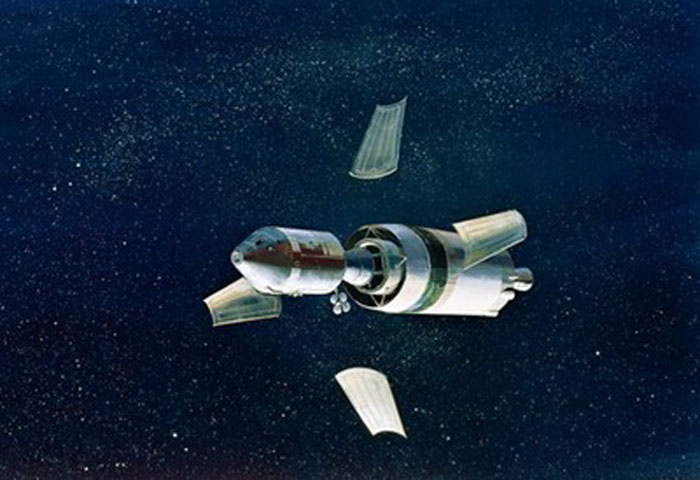.

An illustration of an Apollo spacecraft separating from its Saturn V upper stage, with several panels flying away. One such panel may have been the source of a flashing light noted by the Apollo 11 crew. (credit: NASA)
.
As Apollo 11 headed to the Moon, the astronauts looked out their window and noticed something—an object, flashing with some kind of regularity.
According to Jay Barbree in his new book Neil Armstrong: A Life of Flight, after they returned to Earth, there was some tension about this subject while the astronauts were in their quarantine module aboard the aircraft carrier USS Hornet (see “Review: Neil Armstong: A Life of Flight”, The Space Review, July 7, 2014). Barbree quoted Armstrong (pg. 300): “From the beginning I felt there was an explanation,” he told me. “We were looking back at lights that steadily flashed—natural lights or human made it seemed to me, and we just didn’t have the facts. I thought we had an obligation not to start some Hollywood frenzy about us being watched and followed by aliens.”
In several different forums Buzz Aldrin has consistently stated that he was pretty sure that the flashing that he saw was part of the Saturn V that had launched them to the Moon:
On Apollo 11 in route to the Moon, I observed a light out the window that appeared to be moving alongside us. There were many explanations of what that could be, other than another spacecraft from another country or another world—it was either the rocket we had separated from, or the 4 panels that moved away when we extracted the lander from the rocket and we were nose to nose with the two spacecraft. So in the close vicinity, moving away, were 4 panels. And I feel absolutely convinced that we were looking at the sun reflected off of one of these panels. Which one? I don’t know. So technically, the definition could be “unidentified.”
Aldrin’s statement about an object “moving alongside” the Apollo 11 spacecraft is consistent with a Saturn Launch Adapter (SLA) panel. It is also consistent with the fact that he saw it going away from Earth and not toward the Earth (a satellite in Earth orbit would have been visible in either direction). It is also consistent with the fact that the Apollo 12 astronauts saw the same thing, and with ground telescope observations that showed the SLA panels traveling with the spacecraft.
In his book, Barbree provides an alternate explanation:
I had earlier learned a top-secret and sensitive American photographic reconnaissance satellite had failed and was tumbling out of control. With each tumble it sent out a reflection from sunrays giving the appearance of flashing lights. My source was solid and he only told me with the promise I would not report it. At the time it could have damaged the country’s reconnaissance efforts severely.
Although Aldrin’s explanation is almost certainly correct, there is quite possibly more than a grain of truth to Barbree’s report. In an August 2012 article in Air Force magazine about the still-classified CANYON series of communications intelligence satellites, Jeffrey Richelson reported that the first CANYON satellite was launched from Cape Canaveral in August 1968 atop an Atlas-Agena rocket. The rocket placed the satellite in an orbit with a 20,256-mile perigee and 24,335-mile apogee and 10.2-degree inclination. This orbit resulted in the satellite tracing a figure eight while rising above the Equator and then falling below it as it traveled between its highest and lowest altitudes.
But according to Richelson, “in maneuvering the satellite, a ground controller made a critical error that sent the bird into an uncontrollable spin, turning it into a highly classified, expensive piece of space junk.” So the satellite, in nearly geosynchronous orbit, was spinning around and around, its solar panels flashing as the sun hit them.
The fact that the August 1968 CANYON launch was the first satellite of its kind probably meant that it was a rather notorious incident within the American intelligence community. It still would have been on the minds of people within that select community less than a year later. Thus, it could have been this satellite that Barbree’s source was referring to when he told him about the incident. However, that does not mean that it was what the astronauts actually saw on their way to the Moon. The SLA panel explanation is far more likely, and the one that the astronauts themselves seem to have settled upon. In spaceflight, as in many things, the simplest explanation is often the most probable one.
Quelle: The Space Review
4558 Views
